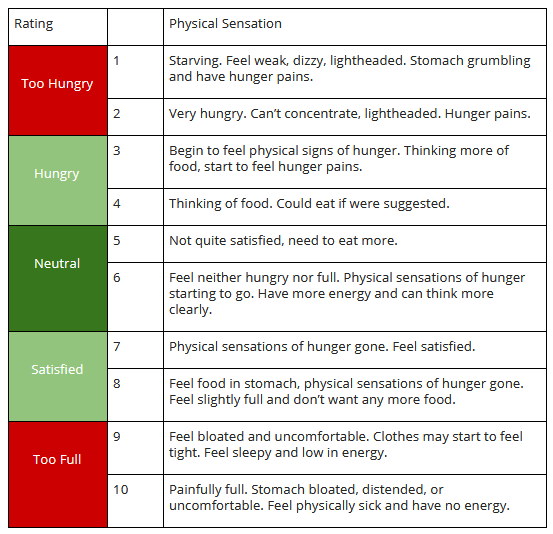Am I Hungry?
Episode #3 of the course Mindful eating by Sanchia Parker
Yesterday, we determined why we are mindless. Today, we will learn one of the skills needed to become a mindful eater.
Over time, we can lose touch with how physical hunger and fullness actually feel. Using the hunger scale can help identify how hungry you really are and decide whether your desire to eat comes from real hunger or some other reasons.
How Hunger Works
When our body has used up energy from our last meal, it causes blood sugar and insulin levels to drop. The drop triggers a hormone called ghrelin to be produced in the gut. Ghrelin travels to the brain to alert the brain that we need food! The brain releases a hormone called neuropeptide Y, which stimulates hunger.
As you are eating, your stomach starts digesting the food. There are special nerves in your stomach that sense when your stomach is stretching (i.e. being filled with food). These nerves alert the brain that you are full, and this stops you feeling hungry so you can stop eating.
However, the trick is being able to listen to these cues to determine when we eat. Before we look at the hunger scale, let’s go back to how it actually feels to be hungry. Since many people have lost their ability to tune into their own appetite signals, it’s important to remind yourself of the characteristics of hunger and sensations associated with it.
Physical hunger:
• increases gradually over time
• causes feeling of emptiness in stomach
• may provoke gurgling, rumbling, or growling in stomach
• sometimes triggers dizziness, faintness, or lightheadedness
• may cause headache
• makes you irritable, easily agitated
• reduces concentration
• may cause nausea
Learn these signs and try to identify them before you decide to go for another meal.
The Hunger Scale
Have a look at the scale below.

• Ideally, you want to start eating at 3 or 4. You want to feel some hunger signals, and eating at this point will allow you to have control over what you will eat.
• You want to stop eating at around 6 or 7 so you feel content but not too full.
• Important: Don’t wait till you’re at 1 or 2. Being starving, irritable, and shaky will almost certainly result in eating a lot of food, quickly propelling you up to a 9 or 10!
I recommend that you print out the hunger scale and stick it on your fridge or at your desk at work. Use it during the day to see where your hunger is. Wait until you are at a 3 or 4 before you eat your next meal.
Tomorrow: Now that you have learned how to identify hunger signals, we can move onto the second technique for mindful eating: playing with your food!
Recommended book
Share with friends

